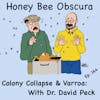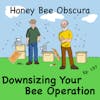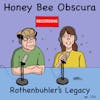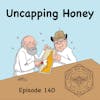Listener Emails: Cutting Down Supers and Dealing with Propolis (145)

In this episode, Jim invites Beekeeping Today Podcast's Jeff Ott, to sit in for Kim to help answer a couple of recent listener emails. In response to a recent episode where Jim talks about dealing with heavy 10-frame, deep supers, a listener sends in...
 In this episode, Jim invites Beekeeping Today Podcast's Jeff Ott, to sit in for Kim to help answer a couple of recent listener emails.
In this episode, Jim invites Beekeeping Today Podcast's Jeff Ott, to sit in for Kim to help answer a couple of recent listener emails.
In response to a recent episode where Jim talks about dealing with heavy 10-frame, deep supers, a listener sends in a suggestion and a question. Jim gives this recommendation thoughtful consideration and discusses the pros and cons.
In a second letter, a listener states that they have a jar full of propolis and wasn't quite sure what he could do with it. Jim and Jeff discuss their experiences (good and bad) with propolis.
Do you collect propolis? What do you do with it? They'd like to hear from you!
Thank you for listening!
______________________
Thanks to Betterbee for sponsoring today's episode. Betterbee’s mission is to support every beekeeper with excellent customer  service, continued education and quality equipment. From their colorful and informative catalog to their support of beekeeper educational activities, including this podcast series, Betterbee truly is Beekeepers Serving Beekeepers. See for yourself at www.betterbee.com
service, continued education and quality equipment. From their colorful and informative catalog to their support of beekeeper educational activities, including this podcast series, Betterbee truly is Beekeepers Serving Beekeepers. See for yourself at www.betterbee.com
______________________
Honey Bee Obscura is brought to you by Growing Planet Media, LLC, the home of Beekeeping Today Podcast.
Music: Heart & Soul by Gyom, All We Know by Midway Music, original guitar music by Jeffrey Ott
Copyright © 2023 by Growing Planet Media, LLC

Episode 145 – Listener Emails: Cutting Down Supers and Dealing with Propolis
Jim Tew: Good morning, listeners. Welcome to Honey Bee Obscura's weekly podcast. I'm happy to say that you've been talking to us via email messages for the last couple of weeks. Two of these have come to mind, more or less. I got to tell you that Kim's still away. We have every expectation he'll be back soon, but Jeff's filling in. Jeff, welcome, buddy.
Jeff Ott: Hey, Jim. Thanks for inviting me on today.
Jim: I've gotten really accustomed to talking to you. You're a good man to have around so we can fall back on you and help us get through these times that we have to get through sometime.
Jeff: I'm glad to be here.
Jim: I've got a couple of comments we've had from readers about propolis and about hive weight. In our previous discussions that we've had are you agreeable to us discussing this and seeing if we can clear up some of the things we didn't clear up before?
Jeff: Let's see how much trouble we can get into.
Jim: Oh, that is probably not a good way to go about it but that'll work. Listeners. I'm Jim Tew.
Jeff: I'm Jeff Ott from Beekeeping Today Podcast.
Jim: We're coming to you to discuss some of these questions we've been getting on Honey Bee Obscura.
Introduction: You are listening to Honey Bee Obscura brought to you by Growing Planet Media, the folks behind Beekeeping Today Podcast. Each week on Honey Bee Obscura, host Kim Flottum and Jim Tew, explore the complexities, the beauty, the fun, and the challenges of managing honey bees in today's world. Get ready for an engaging discussion to delight and inform all beekeepers. If you're a long-timer or just starting out, sit back and enjoy the next several minutes as Kim and Jim explore all things honey bees.
Jim: I got to tell you that the first listener who sent us a response, really calls me to go bike, Jeff, decades and decades and decades ago. Dabbler, I think is probably his handle, wouldn't you think?
Jeff: Yes.
Jim: It may be his name. So, Mr. Dabbler, if that's your name, we're not trying to be comical here, we're just trying to communicate with you about this but you told us, "Why don't we cut the boxes down?" That was really insightful. For those who don't know what he's talking about, you set your table saw up, you adjust your fence to make a 6 5/8-inch cut, and you cut off what would be about a 2.5-inch rim. That's really useful for something you're just not sure what.
Jeff: Jim, I'm not a woodworker, but just to clarify it, that's cut off at 2.5 inch off the bottom of that, super.
Jim: Yes, absolutely. If you cut it off the top, then you've just got a flower box.
[laughs]
Jeff: I just want to make sure because the first cut I would make would probably be on the wrong side, guaranteed.
Jim: Well, you need to do that one time and then you won't do that again. I'll also, when you assemble that box, go ahead and put the hand holes inside one time, and then you won't ever do that again either.
Jeff: I've done that too.
[laughter]
Jim: Well, the reason I was interested to get the response from the listener was that because the very first, number one, the very first lab I went to in my beekeeping class at Auburn, I realize now he was an old guy, but my professor had students cutting down boxes on the university table saw. Above the den of the saw running and nails flying and sparks striking the nails as they cut through, I might add something that really shouldn't have been done quite like that in a crowd but nonetheless, it was then, not now, he said he was just too old to pick up those heavy boxes anymore, and he wanted to cut them all down.
I think that the handhold may be positioned slightly different, but I've noticed in some of those cut-down boxes the handholds seem to be a little bit lower down. We were cutting down those boxes then, and he said, and I got to finish this, I'm wasting my time here. "Anybody want these cutoff rims?" Well, of course, I wanted them, Jeff.
Jeff: [chuckles]
Jim: They went right to my car. These are perfectly good things. Whatever they are, these 2.5-inch rims but they ended up being remarkably useful, and I used every one of them. You put a board on them, and they become kind of a candy board feeder or you put an 8-mesh screen on the top and they become a transportation screen for moving bees. Yes, we cut them down, Mr. Dabbler. If anybody takes that on, I need to tell you to be careful with that.
You need to wear some serious protection because you won't get those nails out. Those nails are probably cement coated, and they're not going back out readily, so you're probably going to have to use a carbide-tipped blade to saw through them. If the blade happens to grab the nail and tear it out, rip it, and then throw it, then you've got this metal projectile flying around your shop. Maybe a saber saw might be a little bit safer, be slower, but there's that. Ask me a question about this, Jeff. What have I not explained clearly on this?
Jeff: No, I'm just envisioning all these sparks and the bits of metal and nails, I think with a faith guard and put the kids in the shed and outback or put them up in the attic so that they don't get hit by anything coming through the walls, any of the shrapnel. Sounds like an exciting time. I think a carbide-tipped blade would be essential.
Jim: The biggest reason that I've never rushed into it, I've told the listeners all through the years. Dad had a small bee supply business and he was just a beekeeper who would buy a bunch of bee stuff and then sell it to his neighboring friends. He didn't make any money but when Dad had to cross over, I inherited probably a thousand knocked down deeps. I've been using deeps all of my life. That's new old stock from Dad's business. The big drawback is you can't cut those frames down so you've got to rebuild every frame and put a 6 5/8-inch frame inside those cut-down boxes.
It was never really worthwhile. Then what do you do with all the deep frames you've got? So you just swapped one problem for another.
Jeff: If you had knocked down boxes sitting on a shelf and you wanted to go mediums from deeps, would it be better than to go ahead and just cut them down as they're broke before you build them then?
Jim: Absolutely. No nails, single board. You don't have this clumsy box on the table saw. I'm trying to think. What would somebody else tell me? You could use a Sawzall. It won't cut straight, it's going to make a messy cut. You could use a saber saw, it's going to be slow. It's going to be hard to make a straight cut. You can put a guide or a fence on a saber saw, but you really don't want to do many more than a few that way.
Jeff: I would think this time of year, in the fall during the time we're recording this, the yellow jackets and hornets and the visiting neighborhood bees would enjoy the saber saw cut because there'd be all sorts of openings to explore.
Jim: Let me tell you the real truth, though, to Mr. Dabbler and to you and to the listeners. That you reach a point in life where just cutting 2.5 inches off the deep, isn't really going to matter that much to you? It's just a question of bending over at all. Never mind bending over and picking up 90 pounds versus bending over and picking up 65 pounds. Either weight is nearly prohibitive. The listener also said, "Why don't you just put some spacers inside?" I've never done that, but I have considered it.
So, put an expanded polished styrene spacer inside, so you've only got 8 frames in a 10-frame colony but you maintain bee space. That's a possibility. That's probably more intriguing than cutting the equipment down. I've never done it, but I've often wondered if that would give more insulatory effects to the remaining eight or seven frames or whatever you chose inside there. Then, Jeff, we're off on a totally different subject that just goes crazy. The bees will chew that styrofoam like crazy. They'll literally eat it. Then if they don't, then carpenter ants and wax moths will burrow through it because it's just so easy to burrow through that.
I've had carpenter ants happily live in the walls of some of my expanded polystyrene plastic hives. Expanded polystyrene.
Jeff: How do the new hives that are coming out that are EPS or expanded polystyrene hives, how do they keep the insects and varmints from chewing away on the styrofoam?
Jim: I don't think they keep them from chewing away. I've had squirrels or something. I don't know what it was but I had something that was chewing on the outside of it. Either squirrels or chipmunks. They would chew wood too, it's not just a-- The styrofoam, the plastic hives are so much easier here to chew. Spacing is a possibility. I like it almost better than cutting them down because I can still use the frames and I can still use the equipment.
Jeff: You could use a big follower board as opposed to just a--
Jim: You could use a follower board. You can make the follower board out of something insulated. The sky's the limit here. You're dabbling, if I could quote Mr. Dabbler, you're dabbling in this and trying to make life easier. It was a great question and spurred me to think, spurred me to remember, and spurred me to accept the fact that I'm not a young man anymore.
Jeff: I wonder what other beekeepers have done besides cutting down equipment. I like the idea of using the follower board or something else in that space. That way you could continue using your existing frames and your equipment and setup. You don't have to change your whole setup to go to all medium equipment if one is all deep.
Jim: I'm going to pull a Jeff Ott here. I'm going to pull a Jeff Ott.
Jeff: You're going to get in trouble?
Jim: No, I'm going to ask you to explain to the listeners exactly, for those who may not know, what is a follower board. It's not a real common piece of equipment.
Jeff: I haven't really used them until I started experimenting with the long hive, but a follower board is a solid piece of-- it looks like a frame without a frame. It has ears that the board will hang where the regular frame sits, but instead of having a bee space on the sides, it goes all the way from the top to the bottom so that fills in a blank space at the end like in long hive or even in a deep so that bees can't go beyond it. It holds up against the last frame and provides that space in there.
Jim: There are useful pieces of equipment. It's a movable petition. You could have 6 frames in a 10-frame colony like an apartment, and you creep, get grazing out in granddad's farm. Go move the fence 15 feet and pick up some fresh forage there for the livestock so you can creep graze or you can creep frame inside the colony.
Jeff: A movable partition. You took my 600 words in the explanation made it into three. I love it. It's perfect.
Jim: I'm glad you brought up follower boards. That was intriguing too because it sometimes was called a division board, and so these division boards, ergo followers, was the concept of a division board feeder. That's why that feeder that hangs in there is called a division board feeder, was because it was first just a movable partition and then it was converted into an open feeder like that. Have we covered this? Yes, cut them down? Yes, put in insulation? Yes, use them like they are? Yes, hire someone younger to come do your work?
All of these things are possibilities for getting by with what to do with the heavy weight of honey when you have either some health issue or age issue that precludes you from doing it.
Jeff: Along those lines, and you mentioned it and I laughed, but there is the option if you are a member of a local club, you could offer to be a mentor to a new beekeeper and have them help you with the hives and the heavy equipment at different times of the year. That way the mentee learns about beekeeping from you, an experienced beekeeper, and then you as the mentor have the help of someone who's younger, stronger, and able to lift and move and is eager to learn what you have to share.
Jim: I agree with all that except maybe the eager word. I don't know how long that eagerness is going to hold up. When you get to colony number 16 to take off deep number 31, that eagerness may be dampened. We've got a second question, but I want to take a short commercial break to hear from someone who'd be happy to sell you follower boards and division board feeders, and whatever else you might need.
Betterbee: Are your bees ready to take on winter? Don't leave them vulnerable to Varroa mites. Introducing Api-Bioxal, the ultimate Varroa treatment for your honey bees. It's the only oxalic acid on the market that's EPA-approved to safely eliminate those pesky mites. Vaporize it. Dribble it. Do whatever it takes to ensure your Varroa numbers stay low as temperatures drop. Visit betterbee.com/oxalic today to learn more and secure your Api-Bioxal to send your bees into winter strong and healthy.
Jim: Jeff, the second question was just as intriguing, and I want to tell Mark S., out of respect, I don't think we should use complete names here, I want to tell Mark S. that this is also an excellent subject. I have, without academic authorization, wondered why we were not more interested in propolis, and why we've never really been interested in propolis, beyond just the formality of dealing with it, scraping it, collecting it, maybe saving some of it, throwing it away, but it has never risen to anything, anything approaching honey and not even much approaching collected pollen.
It's just always out there, the unloved hive product. I used to give a PowerPoint topic on this and that was the name I gave it, propolis, the unloved hive product.
Jeff: I will profess my ignorance about propolis. To me, historically, propolis has always been propolis, propolis, propolis, it has always been more in the way than it's been helpful. It glues the hive bodies together. It glues the frames to the side of the top of the rabbit, the bottom of the rabbit. It's on my hive tool all over the place. It permanently stains my jacket, my bee suit, and ruins pairs of jeans.
Jim: It also gives you something to do while you're sitting in church on Sunday mornings. You can try to get that propolis off your hands that's there from the bee work you did the day before. It's sticky, sticky stuff.
Jeff: It smells good. I will say that.
Jim: It does smell good.
Jeff: It smells very good.
Jim: I better go, you've stumbled over the word a bit as I think you should have, because to some it's propolis, to others it's propolis, and to still the third group, it can be occasionally called propolis, meaning before the city. I don't know exactly why, I guess because they would propolize the entrance closed.
Jeff: That's a good idea. At night, do you put your head on a pillow or a pellow?
[laughter]
Jim: I'm more of a pillow person than a-- What was the second one? Pellow?
Jeff: Pellow, yes.
Jim: You sound like you're from somewhere in the south where I'm from, you do a pellow.
Jeff: We used to get in fist fights in grade school, but go ahead. I like that. What'd you call it?
Jim: Propolis, the last one.
Jeff: That's really good.
Jim: It has an exotic sound to it, doesn't it? You're not just a regular beekeeper. You're a sophisticated out-there beekeeper who's worried about propolis. We're probably offending people who pronounce it that way. I don't mean to, it's just--
Jeff: When you think about an opening in a hive, it is, and many times, narrowed with propolis, propolis, propolis. I like that explanation. I like that, can't remember the terminology, but I like the way that is the beginnings of that word. It's before the city. I like that.
Jim: Before the city. Mark said he had a half of jam jar filled full of raw propolis. By the way, I use the word propolis. I don't know. I got to choose one of them, so I'm in that category. Now what do you do with it? Mark, you sound so much like me. I'd never throw propolis away. In fact, I've tried to be funny about it. I usually take these droppings and pieces of propolis while they're nice and pliable, and in the hive and the spring, they're really pretty and they're soft. I'll just wad these things into a golf ball size ball, and I've just called these things propolis balls.
They're under the seat of my truck. They're in my shop. They're in my little bee house, and they just sit there waiting for the day that I have a serious need for propolis balls. Because I don't really know what I'm going to do with them. Now here we go, Jeff. Probably people who use us to make tinctures and natural medicines and whatever think how useful or uninsightful we are, but I don't know what to do with it. I've collected propolis. You can buy those propolis collecting grids at most bee supply places.
It looks like a plastic queen excluder and you put it on top of the colony and the bees just hate that space. They can't get through, but wax moth larvae, I guess they're pest ants, whatever can get through. They will work themselves to death in the spring of the year when these big gums are available, and they'll fill those grids up and then you put it in the freezer and carefully take it out because if you hit it too soon, you'll have the little propolis, propolis pieces everywhere. Then you shatter it over a collecting container and then you've got nice, fresh, clean propolis to do whatever it is you're going to do with it.
You can dissolve it in alcohol. I've had good luck just using common alcohol hand cleaner to get propolis and wax off my hands and to tell you the truth, using Q-tips and whatever and really off the subject to get it off my cameras. I can't get off the subject, Jeff, but I've never heard how any professional photographer keeps propolis and wax off their photographic equipment when they're in the heat of battle. Never mind, honey. I have pretty good luck trying to use one hand to use my camera and trying to use the other hand to do something with the bees and get propolis on it and then get it on my photographic gear. I've had pretty good luck using that alcohol hand cleaner to get it off.
Now, back to the subject at hand. He's got a jam jar full of this stuff, what to do with it? At this point, I want to buy some time. Maybe when Kim's back, maybe you and I again, but other than just keep it, it's worthy of something. Don't throw it away, but I can't really tell you right now. what to do with it? It floats. You need to get the wood chips out of it, get the dead bees out. Clean it up as much as you can. You can render it down in alcohol. In an earlier life when I had a lot more energy and enthusiasm, I used various diluting compounds to liquefy it.
I tried to make a paint varnish out of it and I built some sample piece and put my propolis protective coating on it. About three months later it finally dried. It was tacky for months and months on end.
Jeff: I was going to ask you, how did your violin sound after that, Mr. Stradivarius?
Jim: I wasn't going to say that, but I will say it. I don't know where I read it and someone is going to call me on it, but I've read decades ago that there was pollen found and some of Stradivarius's finishes on his violins and someone was conjecturing that he was using propolis. Now at this point, let's just call that an urban legend because I don't have a citation for that point.
Jeff: His violin shop had flowers outside the windows.
Jim: On this final note, bees love that stuff and they will reuse it. They will readily reuse it. So far as I can tell, if you've been a bad bee and you've not done your job, then you're going to be put on gum collection duty because it's a miserable thankless job. Since I don't have beautiful equipment, if I've got a lot of propolis, I'll just lay it back on the hive top and then what I've found, since I photograph bees a lot, is that they will go back if it's in the season and try to collect that warm propolis again and reuse it. They're very tolerant of being photographed right there on the hive lid. It's always just a small number of bees that are delegated to this.
Marcus, if you'll let me buy some time, I'd love to talk about this more, but I wanted you to know that we did get your question and it was a good question and we did enjoy talking about it.
Jeff: Maybe if any of the other listeners have a regular use for propolis, they can write in and leave comments in the show notes and let us know. Maybe Jim can read your letter in the future.
Jim: Said differently, maybe, tell us how to answer Marcus' question.
Jeff: You are just using a meat cleaver on words today. You're doing good. You're doing good.
Jim: I always enjoyed talking to you. I'll look forward to talking to you or Kim or talking to someone. I want to talk about bees any chance I get. Thanks, Jeff.
Jeff: Thanks for inviting me on.
[00:22:52] [END OF AUDIO]
New to Honey Bee Obscura Podcast?
Here are some great episodes to start with. Or, check out episodes by topic.













